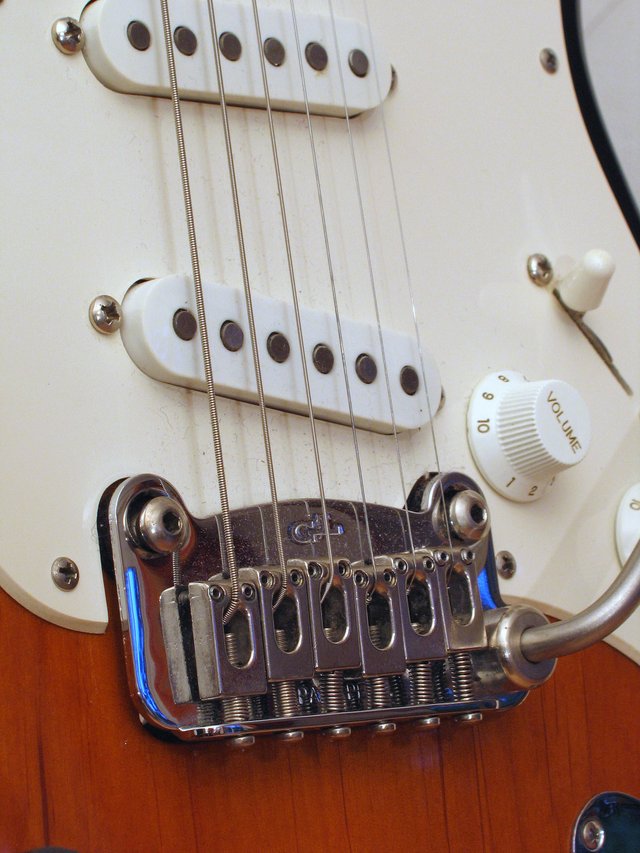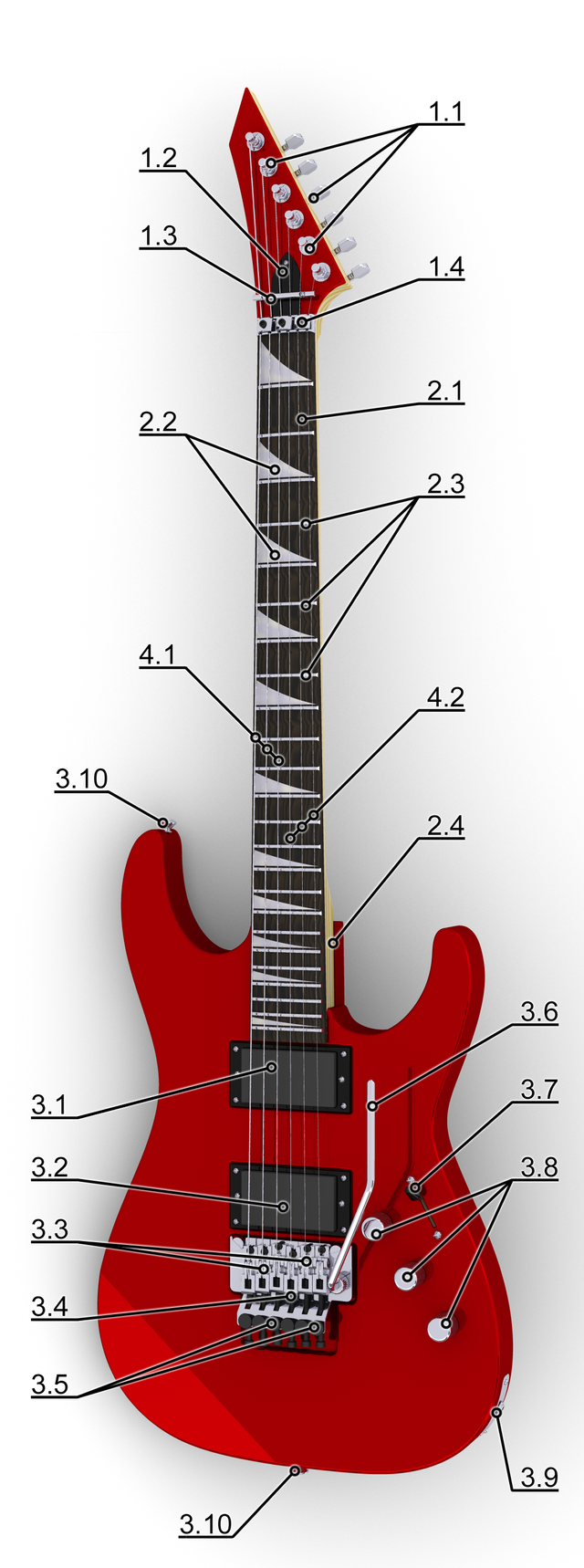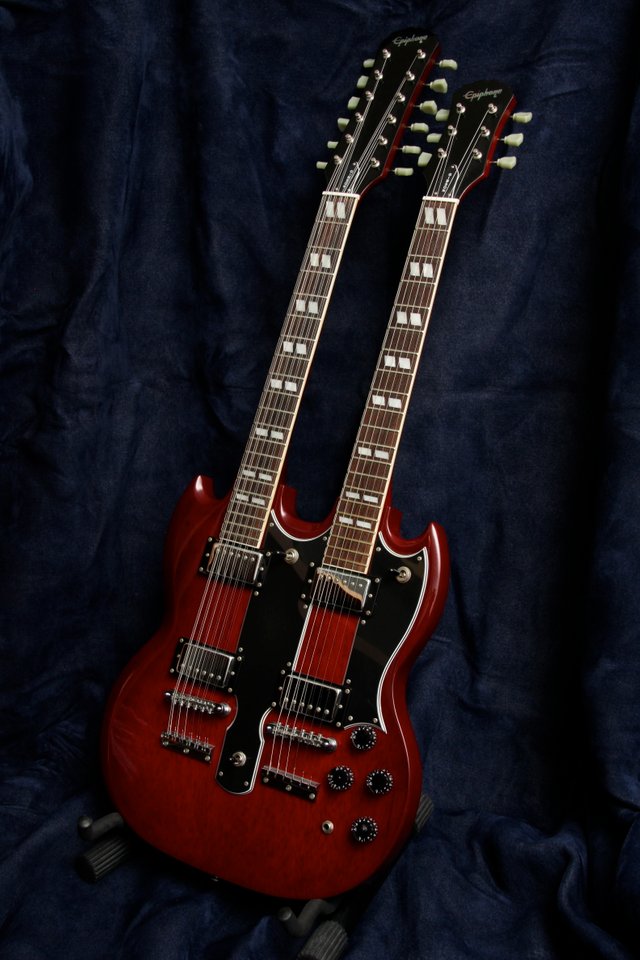Electric Guitar.
In general Guitar is a musical instrument from a string group with a resonant box, fingerboard and frets on the fretboard. It usually has 6 strings. At the end of the 19th century violin makers began to wonder how to strengthen the quiet sound of a classical guitar. As a result, a new type of guitar was created, which we now call Acoustic Guitar.
The acoustic guitar differs from the classical guitar, among others a larger, otherwise contoured resonance box, having a flat or convex top panel, narrower griffin, and above all metal strings, which replaced the used in the classical guitar nylon strings. These changes significantly improved the volume of the guitar, but not so much that it could be fully used in complex bands. So there was the thought of electric sound reinforcement of the acoustic guitar, which gave born to a family of Electric Guitars.
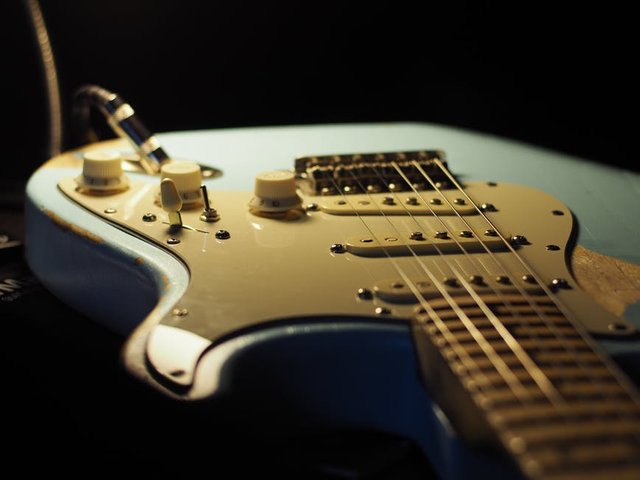
The first electric guitar was made in 1935 in the USA. The instrument, constructed at the kitchen table by the unemployed technician George Beuchamp and the luthier Paul Barth, was baptized with a caressing nickname "Pan". The idea of electric guitar production was picked up by the Swiss entrepreneur Adolph Rickenbacker. Until 1939, 2,700 copies of the "Pan" were produced. Soon there were new improved guitar models. The new instrument has revolutionized the face of popular music. George Beuchamp constructed it using simple tools and materials found at home: pieces of wire, magnets. He constructed the first guitar transducer. Earlier in 1925, wanting to strengthen the sound of the guitar, Beauchamp experimented fruitlessly with the needle of a turntable. Invented by him and later patented transducer was used in the first electric guitar.
The producer of musical instruments, Gibson, created a team working on the construction of a transducer similar to this Beauchamp. As a result of work in 1935, the famous ES-150 electric guitar was created. It was a guitar with a resonance box, with openings on both sides of the base of the neck, characteristic of string instruments. It also had a set of new construction transducers. The guitar has gained great popularity. From the beginning, it sold in large quantities. One of the first owners was Charlie Christian, big band guitarist of Benny Goodman and his friend, bluesman T-Bone Walker.
Despite its unquestionable success, the ES-150 caused some problems: unwanted vibrations, noises, feedback and other sound defects. Gibson's engineers had problems identifying their sources. The inventor and guitarist Les Paul presented an unexpected solution. His idea was a guitar without a resonance box. Les Paul called it The Log. It is true that the front part has holes similar to those in the ES-150, but these were only dummies. For Gibson, such a solution turned out to be too radical and the project was abandoned. The energy of the Gibson constructors was directed towards the improvement of the ES-150.
In 1949 another guitar producer, Leo Fender, made his debut on the market the first commercial guitar without a resonance box, initially called Esquire. Later, the name was changed to Broadcaster, to finally be called Telecaster. The guitar, which has two single-coil pickups, a three-position switch that selects the transducer or their combinations, and two potentiometers, is still produced virtually unchanged. Telecaster, comfortable in the game, became a popular guitar among jazz and country musicians, and from the mid-fifties also rock and roll.
Gibson, convinced of Fender's success, decided to return to the idea of a guitar without a box. He invited the previous originator to cooperate with and in 1952 one of the most famous and produced models was created, which name honored the inventor, Les Paul. Gibson Les Paul was characterized by a warm and gentle sound and was very comfortable in the game. Soon too, despite the exorbitant price, it became very popular.
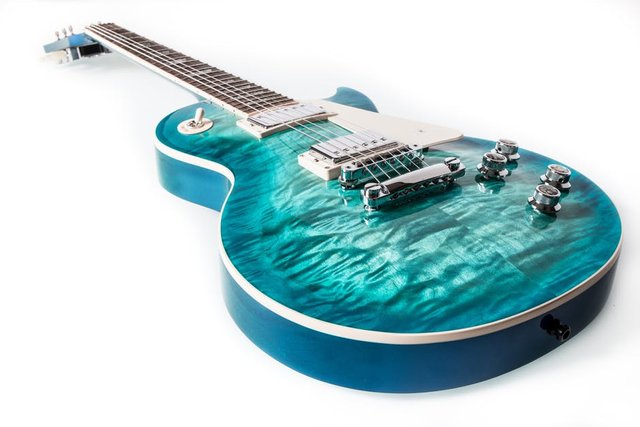
Principle of Operation
An electric guitar differs from the usual one in that it requires appropriate amplifying equipment for its use. However, before we look closer at this apparatus, we will devote some space to the guitar itself. Its principle of operation is by no means complicated. Magnetoelectric transducer, is an essential element of the instrument. The transducer consists of a permanent magnet and two reels close to its poles with a winding made of thin insulated wire. The whole is placed directly under the steel strings of the instrument. During the game, the set in motion changes its distance from the front of the magnet. In turn, this causes changes in the magnetic flux in the system and the induction of electromotive forces in the winding. The electrical voltages produced by the converter match the vibrations of the string and therefore the sounds it produces. These voltages should then be adequately amplified and reproduced through the loudspeaker. The air vibrations generated by the loudspeaker pick up the listeners as sound sensations.
Dual-Fulcrum Vibrato, Fender guitar with single coils.
To be more precisely, the principle of electric guitar operation is based on electromagnetic transducers. Inside the transducer there are bar magnets or cylindrical magnets, and a coil of very thin wire is wound on the coil. The whole is placed just under the strings. As a result of the vibrations of metal strings in the constant magnetic field of the transducer magnets in the coil, a voltage is induced, which as an output signal from the guitar is transmitted to the amplifier, where it is processed and amplified, often also subjected to overdriving.
In the case of electric guitars, in which there are two or three pickups, the sound can be changed using a 3- or 5-step switch located next to the guitar's potentiometers. This switch does not exist when there is only one pickup.
Construction
Electric guitar design and construction vary greatly in the shape of the body and the configuration of the neck, bridge, and pickups. However, some features are present on most guitars.
Electric Guitar based on ESP KH model.
1. Headstock
1.1 machine heads
1.2 truss rod cover
1.3 string guide
1.4 nut
2. Neck
2.1 fretboard
2.2 inlay fret markers
2.3 frets
2.4 neck joint
3. Body
3.1 "neck" pickup
3.2 "bridge" pickup
3.3 saddles
3.4 bridge
3.5 fine tuners and tailpiece assembly
3.6 whammy bar (vibrato arm)
3.7 pickup selector switch
3.8 volume and tone control knobs
3.9 output connector (output jack)
3.10 strap buttons
4. Strings
4.1 bass strings
4.2 treble strings
Let's start with the pickups. They are a very important part of the electric guitar, because thanks to them the guitar sends a signal to the amplifier. Transducers are divided into singles and humbuckers. Simply put, singles sound brighter and humbuckers darker. In addition, singles, especially with strong distortions, brume (they seem to be a constant, unwanted sound). Humbuckers are devoid of this disadvantage.
Let's get to the wood issue. The material from which the guitar body is made influences the sound very much. If we are looking for balance in all sound frequencies, the best option is alder. If the top, hard bass and center frequency, ash or even a brighter maple should be good solution. Lime strengthens the middle sound frequency, while the poplar does the same, additional slightly strengthening the basses. Mahogany emphasizes in a large extent the bottom and center.
The length of the fretboard affects the distance between the thresholds. An important parameter for the convenience of playing is the radius of the fingerboard. These with smaller radius, are very comfortable in the rhythm game. On the other hand, fingerboards with a larger radius make the playing game easier, especially when we focus on playing fast.
The thresholds in the guitar can vary in size. Thanks to the large thresholds, you can use less force when pressing the strings, and using smaller ones improve their feel of the fingerboard. Nesxt part is bridge. Bridge is a metal part connecting the strings to the body of the instrument. The most popular are three types of bridges:
- Fixed
- One-sided mobile
- Both-sided movable with a locked saddle, for example - Floyd Rose
Influence on the Culture
In South and North America, the guitar played an important role in both classical and folk music. In North America, blues music began to develop in the southern states. It initiated the bond between guitar and blues, which became the basis of popular music in South America and around the world. The increase in popularity of the guitar in the 20th century coincided with the progress in recording sound for the movies, which helped to give it a special rank. The guitar was also an inseparable part of country and western music, which gained widespread popularity in the 1930's, thanks to recordings and movies. The guitar, as the preferred accompanying instrument, began to displace the banjo of jazz music and other instruments.
Epiphone G-1275 double neck guitar.
The 20th century made the electic guitar the most favorite instrument. It is easy to adapt, carry, attractive, and its versatility makes it used in a variety of ways. It is one of the best adapted string instruments for both playing chords and melodies. The development of instruments and different approaches to music, and different styles corresponding to almost all tastes and needs have led to the born of many different techniques of playing the guitar. Artists such as Jimi Hendrix, Muddy Waters or Johnny Cash appeared, who created their own styles, and also began to have a significant impact on the consciousness of society through their music. In the 1950s, the first two-guitars of electric guitar appeared. At the beginning, a smaller mandolin neck was added to the guitar body, with time also a second guitar neck, for example 12-string (Gibson's model). This guitar was significantly irritated by Led Zeppelin guitarist Jimmy Page.
In addition
An electronic amplifier with a loudspeaker is a necessary addition to the electric instrument. this problem is relatively low and complex, because the amplifying apparatus is complicated. It is worth remembering that the final effect, that is the sound of the instrument, is decided by the amplifying apparatus, not by the guitar itself. The guitar, or more precisely its transducer, provides signals of approximately similar quality in each case.
Guitar amplifier design uses a different approach than sound reinforcement system power amplifiers and stereo systems. Audio amplifiers generally are intended to accurately reproduce the source signal without adding unwanted tonal coloration or unwanted distortion. In contrast, most guitar amplifiers provide tonal coloration and overdrive or distortion of various types. A common tonal coloration sought by guitarists is rolling off some of the high frequencies.
References:
[1]http://www.fonar.com.pl/audio/projekty/wzmacniacze/wzm17/wzm.htm
[2]https://muzyczny.pl/46_artykul_Gitara-elektryczna-parametry-i-funkcje.html
[3]http://budowagitary.pl/wp-content/uploads/2015/01/Mayones_guitar_Manual_PL.pdf
[4]http://alegitara.pl/budowa-gitary-elektrycznej
